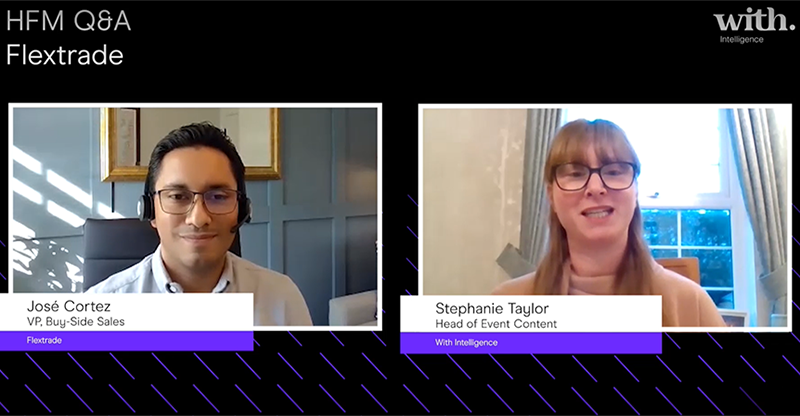API Integrations in the Modern Buy-Side OMS
March 14, 2023 | By: Emily Meyer

VP of Buy-Side Sales at FlexTrade, Jose Cortez, shares insights into API integrations for the buy-side OMS in an interview with Stephanie Taylor, Head of Event Content at WithIntelligence.
What are a few of the challenges that firms might be currently finding with their existing API frameworks?
When I think about challenges that buy-side firms face with current existing API frameworks, the first thing that comes to mind is the technological compatibility between systems. This is both between a vendor solution and internal manager systems, and vendor to vendor. When you are building a complex integrated technology stack, that compatibility is a big piece.
The second is the complexity of implementation. We know that implementing API’s requires a certain level of technical expertise and is certainly something that all managers must contend with and potentially take a head on.
And the last challenge is legacy vendor platforms. This is an interesting one, because it usually comes up when a system has been in place for years and a firm is looking to expand their API capabilities in house. Generally, they will run into problems due to a legacy system being the bottleneck.
How would you say the API system is evolving or has evolved in the alternative investment management space? And as a follow-up, what should managers be doing day-to-day to make their systems run more efficiently and effectively?
We have seen that managers are looking to integrate systems and data tightly across the board. With that, we see internal talent that has the capabilities today to develop new workflows and analytics technologies themselves. To run more efficiently and effectively, managers need to balance between what they can develop more robustly and at scale internally, versus what a vendor solution can provide. When you couple that with a vendor’s value-added workflow, you can get a nice balance.
An example is when we think about the quant manager that has the internal capability to build out an idea generation engine, and then leverage an order management systems API’s to call pre-trade compliance on a what if basis, get short locates, mark orders, and complex allocation schemas. The manager owns and controls their special sauce, while tightly integrating with operational workflows that a vendor can provide. It gives you the best of both worlds.
How can managers overcome issues that are created by legacy buy-side OMS systems and providers that may already be in place? and how easy and cost effective is it to replace those legacy systems?
Most managers rely on building internal solutions beyond what we just described – above and beyond the alpha idea generators or other solutions that they build on their own accord.
That happens because they are hindered by these legacy platforms. They are forced to build operational workflows outside of what they may want to handle, and over time these solutions then take on a disproportionate number of operational workflows. It might take time, but managers start to realize that these legacy systems in their technology stacks are nothing more than data conduits or pastures between their systems. It no longer adds value.
When it no longer adds value, that is the cost borne by the manager and the technology teams internally. When you think about what is cost effective, and how easy it is to replace these systems, a big piece is understanding what that sunk cost is versus how you can build something that is scalable for business growth.
Managers should be careful in evaluating their current technology stacks. Identify the legacy systems in place and identify vendors that have open API capabilities natively versus those who have added it on piecemeal.
Modern platforms like FlexTrade are built API first. The entire notion of having the order lifecycle captured via API’s is something that we have done from day one via gRPC API’s, which gives clients a language agnostic framework to build flexible integrations across the board.
What changes do you think alternatives managers will make to their API frameworks to ensure that their usage is as comprehensive and as coherent as possible, particularly as they look to scale?
The trend we continue to see on the buy-side is managers pushing their technology partners to expand API frameworks. This includes not only user interface workflows via API’s, but making the underlying API framework more resilient from a technology infrastructure standpoint.
As more of these workflows are integrated within, and among, different systems via API, managers need to ask questions like: can the GUI handle the same capacity as the API? Can the GUI keep up with the API’s itself? and can it handle the same capacity and the same throughput? Can it handle hundreds of thousands of orders a day and then process the millions of executions?
Beyond a quant and systematic workflow, more data vendors will integrate with internal and order management systems. Think of factor data, fundamental research data, ESG data. These data points are going to expand exponentially. Being able to integrate that amount of data via API will require a robust framework around how to handle that data flow. On top of that, security is always at top of the mind. Creating a secure framework around how that data is accessed is important.
Want more information?
Request a Demo
"*" indicates required fields